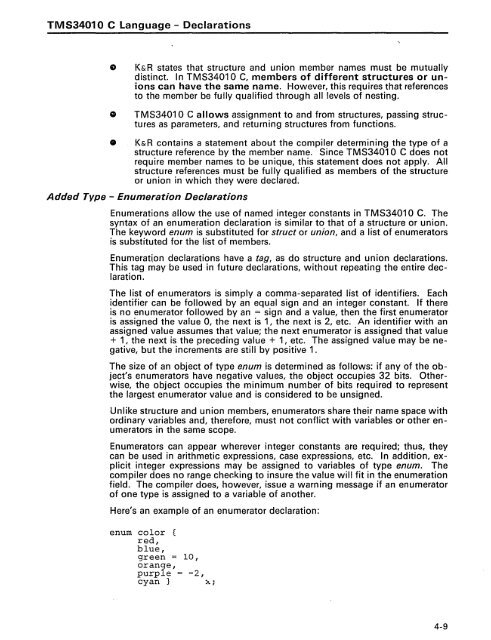TMS34010 C Compiler - Al Kossow's Bitsavers
TMS34010 C Compiler - Al Kossow's Bitsavers
TMS34010 C Compiler - Al Kossow's Bitsavers
You also want an ePaper? Increase the reach of your titles
YUMPU automatically turns print PDFs into web optimized ePapers that Google loves.
<strong>TMS34010</strong> C Language - Declarations<br />
• K&R states that structure and union member names must be mutually<br />
distinct. In TMS3401 0 C, members of different structures or unions<br />
can have the same name. However, this requires that references<br />
to the member be fully qualified through all levels of nesting.<br />
o<br />
<strong>TMS34010</strong> C allows assignment to and from structures, passing structures<br />
as parameters, and returning structures from functions.<br />
• K&R contains a statement about the compiler determining the type of a<br />
structure reference by the member name. Since TMS3401 0 C does not<br />
require member names to be unique, this statement does not apply. <strong>Al</strong>l<br />
structure references must be fully qualified as members of the structure<br />
or union in which they were declared.<br />
Added Type - Enumeration Declarations<br />
Enumerations allow the use of named integer constants in TMS3401 0 C. The<br />
syntax of an enumeration declaration is similar to that of a structure or union.<br />
The keyword enum is substituted for struct or union, and a list of enumerators<br />
is substituted for the list of members.<br />
Enumeration declarations have a tag, as do structure and union declarations.<br />
This tag may be used in future declarations, without repeating the entire declaration.<br />
The list of enumerators is simply a comma-separated list of identifiers. Each<br />
identifier can be followed by an equal sign and an integer constant. If there<br />
is no enumerator followed by an = sign and a value, then the first enumerator<br />
is assigned the value 0, the next is 1, the next is 2, etc. An identifier with an<br />
assigned value assumes that value; the next enumerator is assigned that value<br />
+ 1, the next is the preceding value + 1, etc. The assigned value may be negative,<br />
but the increments are still by positive 1.<br />
The size of an object of type enum is determined as follows: if any of the object's<br />
enumerators have negative values, the object occupies 32 bits. Otherwise,<br />
the object occupies the minimum number of bits required to represent<br />
the largest enumerator value and is considered to be unsigned.<br />
Unlike structure and union members, enumerators share their name space with<br />
ordinary variables and, therefore, must not conflict with variables or other enumerators<br />
in the same scope.<br />
Enumerators can appear wherever integer constants are required; thus, they<br />
can be used in arithmetic expressions, case expressions, etc.· In addition, explicit<br />
integer expressions may be assigned to variables of type enum. The<br />
compiler does no range checking to insure the value will fit in the enumeration<br />
field. The compiler does, however, issue a warning message if an enumerator<br />
of one type is assigned to a variable of another.<br />
Here's an example of an enumerator declaration:<br />
enum color<br />
red,<br />
blue,<br />
green 10,<br />
orange,<br />
purple -2,<br />
cyan } :X;<br />
4-9

















